If you are wondering “Why is my dog’s eye swollen?”, the culprit could be one of the 10 conditions integrative veterinarian Dr. Julie Buzby is about to discuss. Learn which eye problems can cause swelling, what other symptoms to look for, and most importantly, when to take your dog to the vet for a swollen eye.
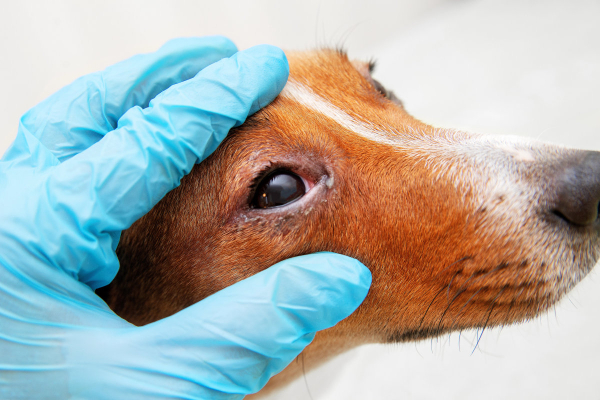
Your dog’s beautiful eyes can easily melt your heart with every gaze. But noticing a problem with your dog’s eyes—like your dog’s eyes being swollen all of a sudden—can quickly put a damper on the moment and make your heart sink.
Important Note: Depending on the cause, swollen eyes can be an emergency. Some eye problems progress rapidly and may threaten your dog’s sight or cause him or her to lose an eye. Head to the veterinary ER if the eye is red, painful, or protruding, if your dog might be having an allergic reaction, or if you believe he or she needs immediate care. Otherwise, promptly give your vet a call and follow his or her recommendations.
Why is my dog’s eye swollen?
When thinking about what causes swollen eyes, It is important to consider which part of the eye is swollen. Sometimes the eyeball itself may be enlarged or protruding more than normal. Other times, it is the eyelids, conjunctiva, and other tissues around the eye that are swollen and puffy.
Ten common conditions that cause swollen eyes in dogs include:
1. Infections
Dogs can develop bacterial, viral, and sometimes fungal eye infections. The conjunctiva—tissue lining the eyelids and reflecting onto the white part of the eye—may swell up as a result of local inflammation. Plus, increased blood flow from the inflammatory process can make the conjunctiva look pinker or red. This is how conjunctivitis, or inflammation of the conjunctiva, earned the name “pink eye.”
In addition to the swollen red conjunctiva, a dog with an eye infection may also have clear, yellowish, or greenish discharge from the eye. Sometimes he or she may also be squinting, holding the eye closed, or trying to rub the eye.
Infection behind the eye
On the other hand, a dog can occasionally develop a pocket of infection behind the eye (retrobulbar abscess). The infectious material and inflammation push the eye forward in the eye socket, making the eye appear swollen. Plus, the dog may have pain when closing the mouth or may be running a fever.
2. Allergies
Similar to what happens with a bacterial infection, conjunctivitis can also occur due to contact with allergens. This could be from pollen, grass, weeds, and trees, or other causes of seasonal allergies in dogs. Or, a food allergy in dogs also can cause allergic conjunctivitis. Additionally, insect stings or bites and exposure to certain chemical irritants or smoke can lead to eye swelling in dogs.
The inflammatory response from the immune system causes swollen conjunctiva around the eye. In some cases, inflammation of the eyelids (blepharitis) is also possible, and the dog may have clear or mucoid discharge from the eyes. Because allergies can cause itchy eyes, the dog may be trying to rub the face on various surfaces or pawing at the eyes too.
Allergic reactions
Dogs can also have a swollen face and eyes due to a sudden allergic reaction to a medication, vaccination, insect bite or sting, or other substance. This is not the same as the allergies that we have been talking about thus far.
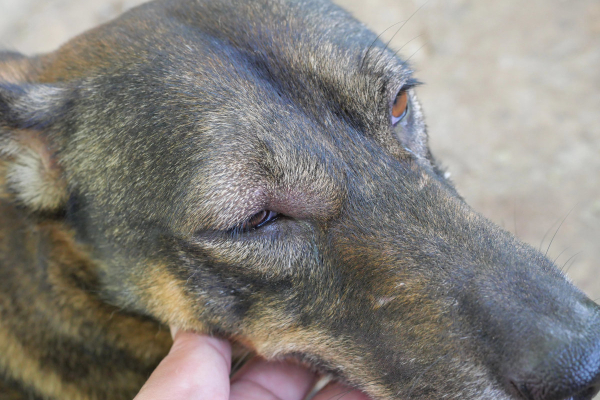
If your dog’s face, especially around the eyes and muzzle, rapidly swells (sometimes to the point it appears the eye is swollen shut), you notice hives on your dog’s skin, or your dog is experiencing vomiting, diarrhea, or difficulty breathing, contact your veterinarian immediately or head to the vet emergency room. Severe allergic reactions (anaphylaxis) can be life-threatening.
3. Trauma to the eye or face
Injuries that affect the eyes or tissue around the eyes can also lead to eye swelling. For example, if the dog gets a scratch on the cornea (corneal ulcer in dogs), the eye may become cloudy, swollen, and painful. Additionally, facial trauma can also cause generalized swelling around the eye on the affected side.
On the other hand, trauma can sometimes push the eyeball out of the eye socket, trapping it in front of the eyelids. This is called proptosis in dogs, and can happen when a big dog shakes a little dog or the dog gets hit with a lot of force. In order to try to save the eye, it is important to make an emergency vet visit ASAP if your dog has proptosis. Unfortunately, studies show that 28% or less of dogs with proptosis will retain vision in the eye.
4. Foreign material in the eye
Even the tiniest bit of foreign debris can be irritating for the eye, resulting in local inflammation of the conjunctiva and surrounding tissues. Common ocular foreign objects include:
- Dirt, sand, or other fine particulates
- Grass, leaves, foxtails in dogs, and other types of plant material
- Fur (from self or other pets)
- Pieces of wood from firewood, furniture, or mulch
- Pieces of plastic from toys or household items
- Insects (especially ticks)
Foreign material in the eye generally causes sudden swelling of the eye and lots of watery discharge. The dog will also often hold the eye closed or partially closed due to the pain and inflammation. (Just think about how it feels when you get something in your eye.)
5. Blepharitis
Blepharitis, or inflammation of the eyelids, occurs as a symptom of many other conditions. Swollen, red, itchy eyelids are the main feature. Additionally, dogs with blepharitis may develop bumps, crusts, or hair loss on the eyelids. If the eyes themselves are involved, the dog might also have conjunctivitis or eye discharge.
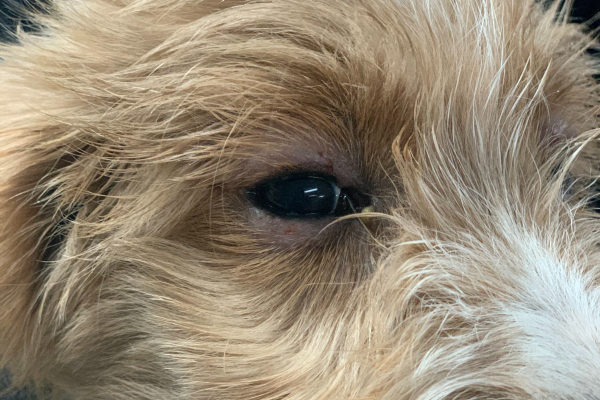
A variety of conditions can cause blepharitis, including allergies, parasites, infections, eyelid abnormalities (such as entropion where the eyelids roll in and ectropion where the eyelids roll out), trauma, and dog eyelid tumors.
6. Keratoconjunctivitis sicca (KCS or dry eye)
Also known as dry eye in dogs, keratoconjunctivitis sicca (KCS) occurs when the tear gland just outside of the eye is attacked by the immune system or injured. As a result, tear production decreases.
Normally, tears form a protective film over the eye to keep it clean and moisturized. When tears are lacking, the eyes can become infected or inflamed, leading to swollen eyes. Plus, the dog may have mucoid eye discharge as a result of the infection and inflammation. KCS can also increase the dog’s risk of developing a corneal ulcer.
7. Blocked tear duct
There are two tear ducts located on the lower eyelids, just on either side of your dog’s nose. Normally, excess tears drain through these ducts and down to the nostrils, keeping the tip of the nose wet and moisturized.
Tear ducts can become obstructed due to infection, inflammation, trauma, and sometimes tumors, all of which may cause an eye to swell. When obstruction occurs, the excess tears usually stain the face just below the affected eye. Also, you may notice a crusty or dry dog nose on the side that corresponds with the obstructed duct.
8. Glaucoma
Glaucoma in dogs (increased pressure within the eye) can cause swelling of the tissues around the eye when it is acute, or enlargement of the eyeball itself in chronic glaucoma. Depending on the cause, glaucoma may affect one or both eyes.
When the pressure first rapidly increases, the eye may be red, cloudy, and painful. The surrounding tissue sometimes swells, but the eyeball itself will appear to be the same size as usual. Acute glaucoma is a vet emergency.
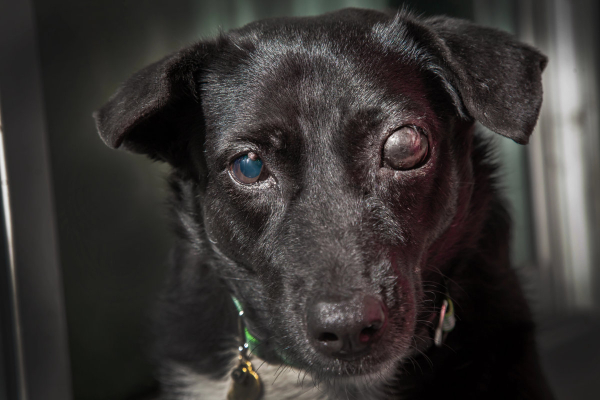
If the pressure remains elevated for a long time, it can stretch out the eyeball. At that point, you can see a size difference between the normal eyeball and the buphthalmic (enlarged) eyeball.
9. Tooth root abscess
Although a dog tooth root abscess doesn’t usually affect the eye itself, it can cause the dog’s face to be swollen on one side just below the eye.
The pocket of infection (abscess) starts at the root of the tooth. But it can spread to the soft tissues in the area. Since the roots of some of the upper premolars and molars live in the bone just below the eye, when they abscess, the swollen area ends up being right below the eye.
10. Tumors of the eye or surrounding tissue
Certain tumors can also be responsible for a swollen-appearing eye. Dog eye melanomas (tumors of the pigment cells) occur within the eye or on its surface. Alternatively, some cancers like lymphoma in dogs, can form behind the eye, pushing it forward in the socket (exophthalmos).
What should I do if my dog has swollen eyes?
As you can see, the causes of swollen eyes in dogs vary considerably in severity. Some conditions like allergic conjunctivitis aren’t likely to be sight-threatening. However, other problems like glaucoma, corneal ulcers, or proptosis, can certainly be both painful for your dog and potentially harmful to your dog’s vision. Therefore, my motto is that you can’t be too careful with eyes.
If you notice your dog has swollen eyes, the best thing you can do is call your vet. The veterinary team will ask you some questions about what you are noticing, potentially look at a picture if you have the ability to send one, and then advise you about how urgently you need to get your dog to the vet.
For some conditions like proptosis or an acute allergic reaction, they may send you to the nearest ER or tell you to come in to the vet’s office immediately. For other problems, you may be fine to schedule a regular visit with your vet.
If you have an E-collar at home and your dog is pawing at the face, the vet may recommend putting it on your dog until you get to the emergency room or clinic. This can help protect the eye from further trauma. Unfortunately, a dog may quickly make some eye conditions worse by rubbing or pawing the eye.
What can I expect at the vet visit?
At the appointment, the vet will carefully examine your dog’s eye and ask you questions about your dog. Next, he or she may recommend testing tear production with a Schirmer tear test, using fluorescein stain to check for an ulcer, and measuring intraocular pressure with tonometry. Sometimes, he or she may also perform additional testing that is specific to what is going on with your dog.
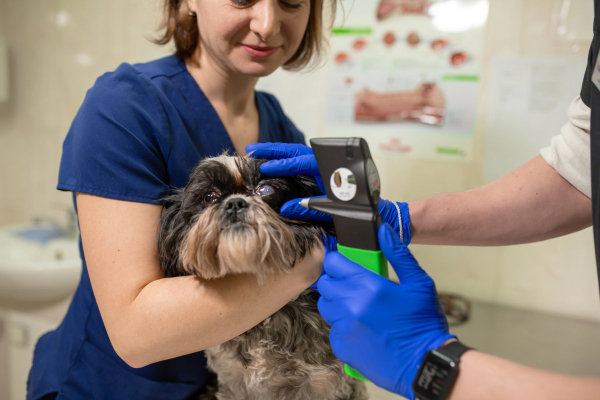
How will the vet treat my dog’s swollen eye?
Treatment for a swollen eye varies depending on the cause. Some potential treatments include:
- Topical antibiotics or anti-inflammatories (steroids or non-steroidal anti-inflammatories)
- Topical or oral medications to reduce pressure in the eye
- Surgery to replace a proptosed eyeball, address a deep or non-healing corneal ulcer, or remove a diseased or damaged eyeball (enucleation)
- Topical immunosuppressives to boost tear production
- Allergy medicine for dogs
- Flushing the eye and removing the foreign material
However, this is not a complete list. Your vet or veterinary ophthalmologist will help you determine what is right for your dog.
Can I treat my dog’s swollen eye at home?
No, you should not try to treat your dog’s swollen eye on your own. Some home remedies can actually worsen the eye condition. Also, trying to treat your dog’s eye at home for a few days before seeing the vet wastes precious time when your dog could be receiving veterinary treatment specific to your dog’s eye condition.
For eye emergencies, time is of the essence, and even some seemingly mild eye problems can worsen quickly without appropriate treatment.
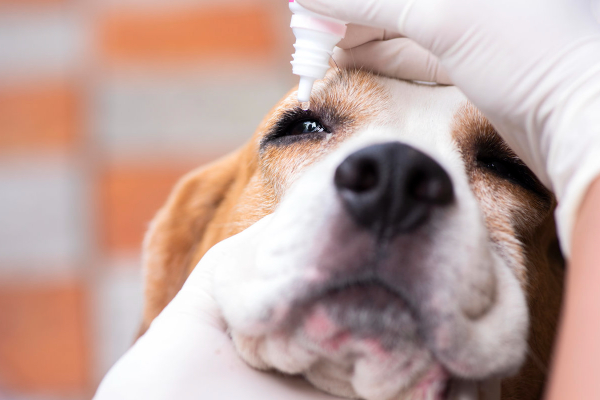
Are there things I can do at home after the veterinary appointment?
In some situations, the veterinarian may recommend the following home remedies in addition to veterinary treatment.
- Warm compresses, which can be soothing and are a good way to remove crusted eye debris. However, it is important to ensure you do not put too much pressure on the eye. Some conditions like a deep ulcer can make the eye more prone to rupturing.
- Over-the-counter eye irrigation solutions, which are generally safe to use for cleaning around the eye. Plus, they are useful for gently flushing debris from the eyes. The solution should not contain any additional ingredients like topical steroid, which can worsen some conditions.
- Topical lubricants and oral eye health supplements if your dog has been diagnosed with dry eye. Keep in mind, though, that they may not be sufficient on their own.
- Benadryl for dogs to calm down a very mild allergic reaction or address allergic conjunctivitis.
Remember though, the things on this list are for mild cases of swollen eyes and should only be tried under the direction of your veterinarian. The best thing you can do for your dog with swollen eyes is to seek veterinary care—not try home remedies
If your dog has a swollen eye, don’t wait
It doesn’t take long for some eye problems to become severe. Thus, if your dog has a swollen eye, it is important to act quickly. Give your vet a call (or head to the ER if it is an emergency situation) and follow his or her recommendations. The sooner you and your vet address your dog’s swollen eye, the sooner you can go back to enjoying his or her beautiful eyes again.
Why was your dog’s eye swollen?
Please comment below.

